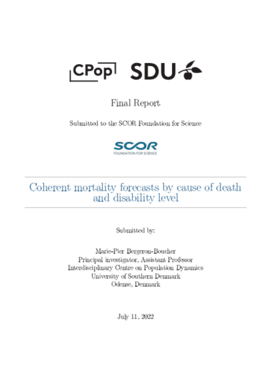Coherent mortality forecasts by cause of death and disability level
Final Report by Marie-Pier Bergeron-Boucher

Valid forecasts of mortality are vital to estimate health care and disability cost, to plan social security policies and to estimate the pension cost. Mortality is usually forecast by age, providing information about the expected age-specific risk of deaths. However, there is also a demand for valid and coherent forecasts for other components of mortality, such as causes of death and disability levels. Providing mortality forecasts for more components would allow one the to know the mortality risks for diverse factors and potentially increase the efficiency of the spending on research, capital investment, palliative care, etc. But there is a reluctance to forecast mortality by other components than ages at death, due to known data and methodological limitations. Given the need for coherent forecasts of mortality by different components, we explored diverse models and developed new ones to provide mortality forecasts by other components than age and identify solutions to methodological limitations.
First, we explored how to forecast mortality by cause of death. One of the remaining issues with forecasts by cause is that they are often inconsistent with all-causes forecasts. This issue relates to how changes in mortality by age and cause interact and how the different methods model this interaction. Should ages and causes be forecast simultaneously or separately? We investigated different approaches and found that forecasting the cause-of-death distribution within each age group generally provides the most accurate forecasts, while avoiding most limitations associated with forecasts by cause.
Second, we explored how to forecast mortality by disability level. Models to forecast mortality by health state remain uncommon. During the duration of the project, we developed models which could (1) forecast simultaneously mortality and health prevalence; (2) consider the dependence between age-groups and between health-states; and (3) account for changes in mortality and health over time. These models solved some of the methodological issues with forecast by health state. They are a first step towards simple and coherent forecasts of the number of years lived in good and poor health.
With the support from the SCOR Foundation for Science, we showed that many of the methodological problems with forecasts that include information on causes of death and health states can be solved or avoided. We hope that future research will build on the developed methods to provide forecasts for multiple components of mortality.”
* * * * *
To know more (details):
